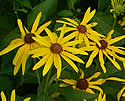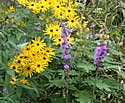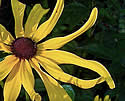Rudbeckia subtomentosa (Sweet Coneflower)
| Also known as: | Sweet Black-eyed Susan |
|---|---|
| Genus: | Rudbeckia |
| Family: | Asteraceae (Aster) |
| Life cycle: | perennial |
| Origin: | native |
| Habitat: | part shade, sun; sandy, loamy, moist soil; wet to mesic prairie, steam banks, woodland openings and edges |
| Bloom season: | July - October |
| Plant height: | 2 to 6 feet |
| Wetland Indicator Status: | GP: FAC MW: FACU NCNE: FACU |
| MN county distribution (click map to enlarge): |  |
| National distribution (click map to enlarge): |  |
Pick an image for a larger view. See the glossary for icon descriptions.
Detailed Information
Flower: 

![[photo of flowers]](/udata/r9ndp23q/pd/rudbeckia-subtomentosa-25-t.jpg) 8 to 25 flower heads at the top of the plant, single at the tips of long stalks and the tips of branching stems. Flowers are 2 to 3 inches across with 10 to 16 yellow petals (ray flowers) that are sparsely hairy and gland-dotted on the underside. The center disk is a purplish-brown, dome-shaped to hemispheric, and covered in up to 400 tiny dark purplish-brown flowers that bloom from the bottom of the disk up. The bracts surrounding the base of the flower are hairy, gland-dotted, unequal in size, lance to egg-shaped with a sharply pointed tip, and the inner bracts smaller than the outer. Flower stalks are ribbed and densely covered in short, ascending hairs.
8 to 25 flower heads at the top of the plant, single at the tips of long stalks and the tips of branching stems. Flowers are 2 to 3 inches across with 10 to 16 yellow petals (ray flowers) that are sparsely hairy and gland-dotted on the underside. The center disk is a purplish-brown, dome-shaped to hemispheric, and covered in up to 400 tiny dark purplish-brown flowers that bloom from the bottom of the disk up. The bracts surrounding the base of the flower are hairy, gland-dotted, unequal in size, lance to egg-shaped with a sharply pointed tip, and the inner bracts smaller than the outer. Flower stalks are ribbed and densely covered in short, ascending hairs.
Leaves and stems: 


![[photo of lobed leaf]](/udata/r9ndp23q/pd/rudbeckia-subtomentosa-75398-3-t.jpg) Leaves are gland dotted and rough-hairy, especially on the underside and along major veins. Lower and basal leaves are up to 8 inches long and 4 inches wide with 3 to 5 lance-elliptic lobes, coarsely toothed around the lobe edges, and stalked.
Leaves are gland dotted and rough-hairy, especially on the underside and along major veins. Lower and basal leaves are up to 8 inches long and 4 inches wide with 3 to 5 lance-elliptic lobes, coarsely toothed around the lobe edges, and stalked.
![[photo of upper stem leaves]](/udata/r9ndp23q/pd/rudbeckia-subtomentosa-5-t.jpg) Mid and upper stem leaves are smaller, unlobed and more egg-shaped, short-stalked to stalkless, sparsely toothed to toothless, rounded to wedge-shaped at the base and pointed at the tip. Stems are branched, mostly erect, ridged, densely short hairy in the upper plant and typically hairless or nearly so near the base.
Mid and upper stem leaves are smaller, unlobed and more egg-shaped, short-stalked to stalkless, sparsely toothed to toothless, rounded to wedge-shaped at the base and pointed at the tip. Stems are branched, mostly erect, ridged, densely short hairy in the upper plant and typically hairless or nearly so near the base.
Fruit: 
The center disk becomes a head of dark, 4-sided seeds that lack a tuft of hairs.
Notes:
Sweet Coneflower has only been recorded once in Minnesota, in Mower County near the Iowa border, putting Minnesota at the extreme northern tip of its range. The flowers are similar to the related and much more common Black-eyed Susan (Rudbeckia hirta), which is easily distinguished by its long spreading hairs and unbranched or few-branched habit. The mix of lobed and unlobed leaves is shared with Brown-eyed Susan (Rudbeckia triloba), which has smaller flowers and a proportionately larger center disk. Sweet Coneflower is occasionally available in the nursery trade and is a personal favorite Rudbeckia species for the home garden.
Native Plant Nurseries, Restoration and Landscaping Services ↓
More photos
 Sweet Coneflower plant
Sweet Coneflower plant Sweet Coneflower plants
Sweet Coneflower plants garden grown Sweet Coneflower
garden grown Sweet Coneflower garden grown Sweet Coneflower
garden grown Sweet Coneflower more flowers with naturally twisted rays
more flowers with naturally twisted rays
Photos courtesy Peter M. Dziuk taken in private gardens in Anoka and Ramsey counties.
Comments
Have you seen this plant in Minnesota, or have any other comments about it?
on: 2015-09-01 10:17:38
pretty sure these are growing in Colinwood Park. Photographed some in July 2015 walking the prairie trail.
on: 2020-06-07 14:47:04
Easily growing from purchased seed, I have these in my wildflower areas, although not locally native here.






